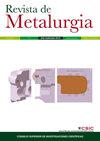用基于RSM的数学模型预测304L不锈钢板FSSW焊区尺寸
IF 0.8
4区 材料科学
Q4 METALLURGY & METALLURGICAL ENGINEERING
引用次数: 0
摘要
300系列奥氏体不锈钢由于其特殊的性能,在工业上得到了广泛的应用。熔焊时的高热量降低了这些钢的性能并引起许多问题。因此,搅拌摩擦点焊作为固态焊接的一种,在高新技术产业中有着广泛的应用前景。本文建立了304L不锈钢板搅拌摩擦点焊的三维动态显式有限元模型。利用该模型,得到了温度分布和焊缝区尺寸(焊缝区厚度)。然后,通过实验研究,得到了温度和焊缝区域尺寸的结果,作为比较和验证数值结果的准则。实验确定了这些区域的显微组织和硬度。最后,提出了基于响应面法的焊接区尺寸预测数学模型。有限元模拟的数值结果、所建模型与实验数据吻合较好。结果表明:最高温度水平出现在搅拌区,并随着焊缝中心的移动而降低;同时,随着刀具转速、切入深度和停留时间的增加,搅拌区和热影响区尺寸均增大到峰值,热影响区尺寸减小。本文章由计算机程序翻译,如有差异,请以英文原文为准。
Predicting the weld zones size in FSSW of 304L stainless steel plates by mathematical model based on RSM
The 300 series austenitic stainless steels are widely used in industries due to their special properties. High heat in fusion welding reduces the properties of these steels and causes many problems. Therefore, stir friction spot welding, which is a type of solid state welding, is useful and widely used in high-tech industries. In this paper, a 3D dynamic explicit finite element model is developed to simulate the friction stir spot welding of 304L stainless steel plates. Using this model, the temperature distribution and the size of weld zones (thickness of weld zones) are obtained. Then, by experimental study, the results of the temperature and the size of weld zones were obtained to be a criterion for comparing and validating the numerical results. Microstructure and hardness of these zones are determined experimentally. Finally, a mathematical model based on the response surface methodology is proposed to predict the size of weld zones. Good agreement between the numerical results that are produced by the finite element simulation, the proposed model and the experimental data is observed. The results show the maximum temperature level appears in the stir zone and it reduces by moving from the weld center. Also, by increasing the rotational speed, plunging depth and dwell time of the tool, the size of both the stir zone and the heat affected zone increase to a peak value and then the size of the latter zone decreases.
求助全文
通过发布文献求助,成功后即可免费获取论文全文。
去求助
来源期刊

Revista De Metalurgia
工程技术-冶金工程
CiteScore
1.30
自引率
25.00%
发文量
18
审稿时长
>12 weeks
期刊介绍:
Revista de Metalurgia is a bimonhly publication. Since 1998 Revista de Metalurgia and Revista Soldadura have been combined in a single publicación that conserves the name Revista de Metalurgia but also includes welding and cutting topics. Revista de Metalurgia is cited since 1997 in the ISI"s Journal of Citation Reports (JCR) Science Edition, and in SCOPUS.
 求助内容:
求助内容: 应助结果提醒方式:
应助结果提醒方式:


